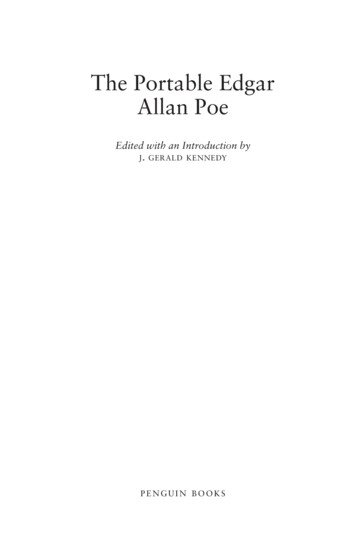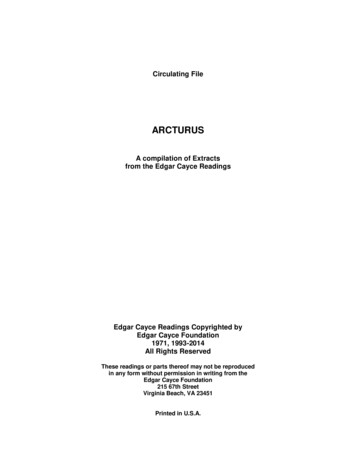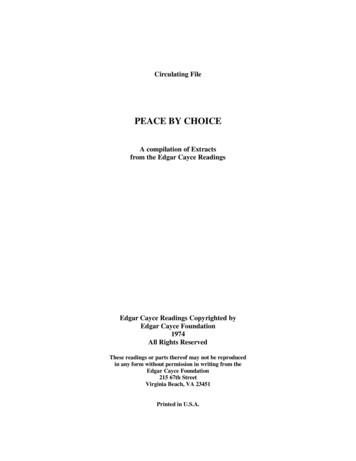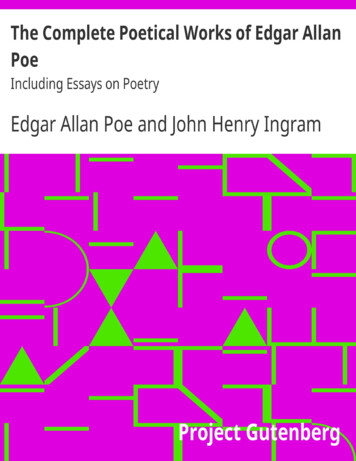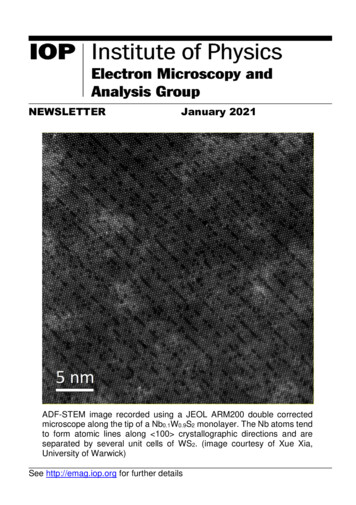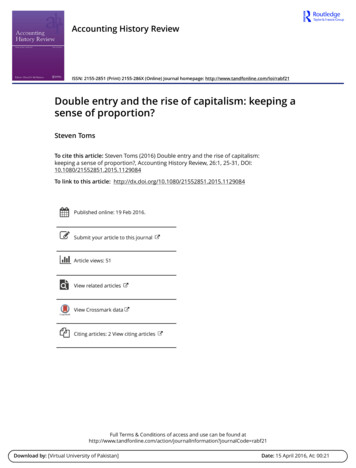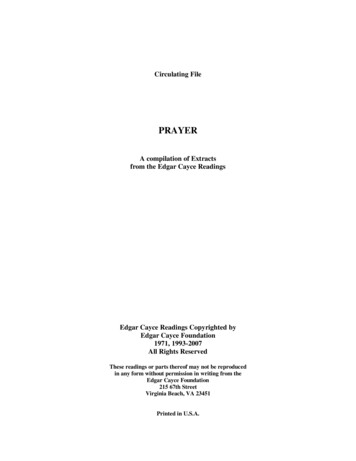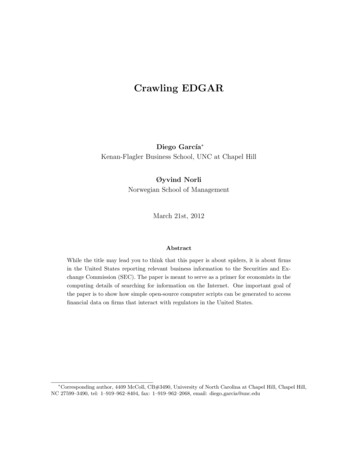
Transcription
Crawling EDGARDiego Garcı́a Kenan-Flagler Business School, UNC at Chapel HillØyvind NorliNorwegian School of ManagementMarch 21st, 2012AbstractWhile the title may lead you to think that this paper is about spiders, it is about firmsin the United States reporting relevant business information to the Securities and Exchange Commission (SEC). The paper is meant to serve as a primer for economists in thecomputing details of searching for information on the Internet. One important goal ofthe paper is to show how simple open-source computer scripts can be generated to accessfinancial data on firms that interact with regulators in the United States. Corresponding author, 4409 McColl, CB#3490, University of North Carolina at Chapel Hill, Chapel Hill,NC 27599–3490, tel: 1–919–962–8404, fax: 1–919–962–2068, email: diego garcia@unc.edu
1IntroductionBusiness relevant information is more easily available today than ever before. Informationabout corporations, investors, and security markets get disseminated through the Internetalmost instantaneously. For the most part, the available information is unstructured in theform of a text. It is easy to see that a strategy of trading on information acquired fromfree form text would become more profitable the faster you are able to read the text. Henceit is not surprising that text analytics is becoming increasingly important on Wall Street.1Hoping to capture the current mood of investors, some traders are using computer programsto monitor and decode the words, opinions, rants and even keyboard-generated smiley facesposted on social networking sites.2 Academia has followed suit. Computerized decoding of“textual information” into quantitative metrics has become an important area of research infinancial economics.This paper is meant to be a teaser to researchers in financial economics that lowers thecosts of entry into the field of text analytics. The paper develops, presents and explains aset of simple Perl programs that will allow access to the electronic filing system (EDGAR)used by the U.S. Securities and Exchange Commission (SEC) to disseminate business relevantinformation. To illustrate how to download and extract information from EDGAR, we useForm 8-K to analyze executive turnover (new hires and departures of corporate executives).We investigate if there is a calendar effect in executive turnover (there is). But the findingson this particular question are not the main point of this paper. Our key contribution is toshow how easy it is to access and analyze the various forms that companies and investors fileelectronically with the SEC.The empirical literature that uses textual data as their main data source is growing. Tetlock, Saar-Tsechansky, and Macskassy (2008), Garcı́a and Norli (2012), Phillips and Hoberg(2010), and Kogan, Routledge, Sagi, and Smith (2009) analyze the annual report filed byfirms on Form 10-K. Another strand of the literature has focused on textual analysis of newspaper articles: Tetlock (2007) picks up investor sentiment by analyzing reports on the stateif the stock market, while Dougal, Engelberg, Garcı́a, and Parsons (2012) use exogenousscheduling of Wall Street Journal columnists to identify a causal relation between financialreporting and stock market performance. Engelberg (2008) analyze earnings announcements,Hoberg and Hanley (2012) study IPO prospectuses.31Text analytics covers tagging and annotations, word counting, pattern recognition, etc. The purpose oftext analytics is to turn an unstructured text into data that can be analyzed.2USA Today, May 4th, 2011, “Wall Street traders mine tweets to gain a trading edge.”3Other related papers include Chan (2003), Barber and Odean (2008), Engelberg and Parsons (2011),DellaVigna and Pollet (2009), Loughran and McDonald (2011), Garcı́a (2012), Solomon (2009), Davis, Piger,1
The rest of the paper proceeds as follows. In section 2 we present some details on theEDGAR filing system. The next section presents a few simple algorithms to extract basicinformation from 8-K statements filed with the SEC through EDGAR. Section 4 presentsan analysis of the calendar effects around aggregate filings of 8-K statements that discussexecutive turnover. The last section concludes.2EDGARCompanies and others are required by law to file a number of different forms with the U.S.Securities and Exchange Commission (SEC). The main purpose of filing these forms is to makecertain types of information available to investors and corporations—and by that improvethe efficiency of security markets. Historically these forms have been filed with the SEC onpaper. In the early 1990s the SEC developed the Electronic Data Gathering, Analysis, andRetrieval (EDGAR) system to handle electronic form filing.4 As of May 6, 1996 all publicU.S. companies were required to make all their filings, with a few exceptions, on EDGAR.More importantly, any person with access to a computer linked to the Internet can obtainand read these filings within seconds after they are filed.As researchers looking for relevant information on companies with operations in the UnitedStates, we have traditionally relied on databases such as Compustat, ExecuComp, SDCPlatinum, etc. These databases are attractive because their owners have collected data fromcompanies’ filings and organized the information in a structured way. Most of the informationthat is found in Compustat comes from Form 10-K. Most of the information in ExecuCompcomes from Proxy filings (Form DEF 14A) and Forms 3, 4, and 5. The merger information inSDC Platinum relies heavily on the forms filed during the period leading up to a merger. Sincethe introduction of EDGAR, researchers have had easy access to this “standard” informationin addition to an enormous amount of information not found in any other database.To get an idea of what type of information that is available through EDGAR we moveon to looking at the most common forms filed with SEC through EDGAR. Table 1 reportsthe filing frequency of the 20 most commonly filed forms over the period 1994 through 2011.and Sedor (2007), Loughran and McDonald (2008).4The SEC describes EDGAR as follows: “EDGAR, the Electronic Data Gathering, Analysis, and Retrievalsystem, performs automated collection, validation, indexing, acceptance, and forwarding of submissions bycompanies and others who are required by law to file forms with the U.S. Securities and Exchange Commission(SEC). Its primary purpose is to increase the efficiency and fairness of the securities market for the benefit ofinvestors, corporations, and the economy by accelerating the receipt, acceptance, dissemination, and analysisof time-sensitive corporate information filed with the agency.” For more information on EDGAR, visit:http://www.sec.gov/edgar.shtml.2
The first column in the Table contains a short description of the form. The second columncontains the form code used on EDGAR. The third column contains the total number oftimes a forms is filed during the whole sample period.The most common EDGAR filing is Form 4. For the sample period 1994–2011 this formis filed more than four million times. Form 4 is used to report purchases or sales of securitesby persons who are the beneficial owner of more than 10 percent of any class of any equitysecurity, or who are directors or officers of the issuer of the security. This form would, forexample, allow you to study the granting of options to officers or directors. Table 1 alsoshows that Form 4/A is a commonly used form. When “/A” is appended to a form code itmeans that the filing is an amendment to an existing filing. Thus, a specific corporate eventcould be linked to an initial filing and a subsequent string of amendments to this initial filing.Form 3 and Form 5, also prevalent in EDGAR, deal with similar ownership issues.The second most common EDGAR filing is Form 8-K, with more than one million filings.Companies have to use this form to file information on issues that are of “material importance” for the firm. The 8-K statements include information on changes in management, newsignificant contracts, merger negotiations, lawsuits, etc. In the next sections of the paper wewill use the 8-K Forms to illustrate how one can use simple computerized parsing to extractinformation from the EDGAR filings.Another important subset of EDGAR is comprised of Form SC 13D (commonly referredto as Schedule 13D) and Form SC 13G. Filing of these forms are triggered when someonecrosses the the 5% ownership threshold in a firm. The 13Ds are “active” investors, say thoseseeking control of the firm, whereas the 13Gs are from “passive” investors. There are on theorder of 1 million such filings (including ammendments).Annually and quarterly statements also figure prominently in the EDGAR system. Thereare well over 400,000 10-Q forms, and over 100,000 10-K statements. Other forms thatcome up in the “top-twenty” list in Table 1 are: foreign firms’ current reports, Form 6-K;forms having to do with issuance of securities, from prospectuses, such as Form 424B3, toexemptions from regulation D; forms specific to institutional managers, such as quarterlyholdings reported on Form 13F.Filers in the EDGAR system are uniquely identified using the Central Index Key (CIK).For the sample perod 1994 through 2011, there are 452,830 unique CIKs in the EDGARdatabase. Only a fraction of these CIKs are publicly traded firms. There are many filersthat are private firms. These private firms include manufacturing firms, but also hedge fundsand mutual funds. You will also receive a CIK if you are filing on behalf of yourself as anindividual.3
Table 2 reports the number of filers (unique CIKs) that file a particular type of form. Wesee there are more than 171,000 filers that have filed a form 4 (or an associated ammendment)at some point during the sample period. There are about 40,000 filers that have filed 13-Ds,with a very similar number of 13-G filers. The total number of firms that file some type of10-K report adds up to over 36,000. This is similar in magnitude to the number of firms thatfile 8-K statements.The three last columns of Table 2 report descriptive statistics on the number of filingsof a particular form (for the subset of firms that actually file that particular form.) Wesee that while the number of firms that file 10-K and 8-K statements is about the same, agiven firm typically files more 8-K statements than 10-K statements. On average, companiesthat file 8-K have typically filed over 30 such statements, while they, on average, only havefiled six 10-K statements. This is most noticable when looking at the last column in Table2, which lists the maximum number of a given form by a given firm. Chase, the financialconglomerate, has filed a total of 1,347 8-K statements. On the other hand, the firm with themost 10-K statements file (Old Republic International, an insurance firm, which filed manyammendments), only has a total of 67 10-K filings. This contrast is also found for other typesof filings. Fidelity has filed over 27,000 13-G statements with the SEC, and GAMCO over5,000 13-D statements.3Downloading Filings from EDGARIn this section we explain how to download filings from EDGAR. The section will walk youthrough the following routine tasks with the EDGAR database: (a) Downloading and readingquarterly master index files. These files contains, among other things, a link to the file forevery form filed during the quarter, (b) downloading and reading all 8-Ks filed during theperiod 1994 through 2011, (c) extracting information from the 8-Ks. We provide a set ofPerl routines that should be easily adapted to particular research projects.5Perl is an open source interpreter language best known for its powerful text processingfacilities.6 This makes it a natural choice for the problem at hand. The Perl code that weprovide in this paper is written for a Unix operating system. But it can be easily adapted5Engelberg and Sankaraguruswamy (2007) also provide a set of SAS routines to crawl EDGAR documents.Our paper is more comprehensive, in terms of laying out a particular question and tackling it directly, as wellas providing some new facts on the EDGAR database itself. Diego is thankful to Joey for prompting him tolearn how to crawl.6Most Unix systems come with Perl installed. For Windows there are several implementations available.We have tested Strawbery Perl with success for this project. The reader may want to search online for aPerl primer, or read the “Camel book” (Wall, Christiansen, and Orwant, 2000).4
for other operating systems.Downloading Quarterly EDGAR Index Files.To be able to effectively downloadcompany filings from EDGAR, you will have to know where EDGAR stores the files associatedwith each filing made through the system. For this purpose EDGAR provide a set of quarterlyindex files. The index file for a specific quarter contains information about every filing madeduring the quarter. The first entry for the last quarterly file of 2011 reads:1000032 BINCH JAMES G 4 2011-12-02 edgar/data/1000032/0001181431-11-058482.txtThe CIK of this filer is 1000032. Since this entry refers to a Form 4 filing, the filer is aperson and not a company. The filing date is December 2, 2011. The textfile associated withthe file can be downloaded 058482.txtYou will find all documents submitted for a given filing in the folder (the last folder name isthe accession number without 1058482/This folder can also be accessed using the http protocoll and your favorite 000032/0001181431-11-058482-index.htmlProgram 1 presents a Perl program that downloads the master files of the EDGARdatabase. The routine starts by calling a package, LWP::UserAgent, which is one of themany packages provided in www.cpan.org in order to interact with the Internet from a perlscript. We include others, i.e. WWW::Mechanize, in what follows. The program then opensa browser, by creating the object ua, and then grabs files from the EDGAR ftp site, goingone quarter/year at a time. The output is saved into 80 different files with the 01QTR3master2001QTR4master2002QTR1master.Each master file can take as much as 30 Mb of hard disk space, especially for files during thelast 10 years. The master files will be the input for the next program.5
Organize Index information by CIK.Although it is possible to access and analyze in-formation in EDGAR filings without downloading and saving any files to you local computer,it is more efficient to have the index files and associated filings saved locally. The reason whythis saves time is that you will have to analyze documents several times during the courseof a research project. Having everything locally implies that you are not vulnerable to thespeed of the EDGAR ftp server. With a fast Internet connection that never goes down onecan leave the files on the EDGAR server and read from there whenever necessary. But, mostof us will not have this luxury.There are many ways to organize the files and the information you download fromEDGAR. We first create a directory structure with individual files that contain the entriesof each individual CIK. This is clearly something of interest, as typically we are interestedon the behavior of particular economic entities. Furthermore, such a directory structure isa must-do when working with the amounts of data that one may need when working withEDGAR. Program 2 breaks the EDGAR master files into smaller master files for each CIK.The program also creates a directory structure with 906 different directories (labeled 000–905). Each directory has 500 different files, where each file stores the content of the EDGARmasterfiles for that particular CIK as a .dat file (the 906 directories work out to take careof the over 450,000 distinct CIKs).Summarizing information contained in the master files. Before jumping into theanalysis of master files, we need to give a small aside on hardware requirements for thisproject. The first one is obvious, sufficient disk space. The raw text files from the EDGARdatabase can take from over 200 Gigabytes for all 8-K statements, to 10-20 Gigabytes for13D/13F/13G statements (10-K statements take up on the ballpark of 100 Gigabytes). Another technical issue is the number of different files one must deal with. On a unix system,our experience is that creating directory structures with under 1,000 “objects” per tree nodeworks well (Program 2 uses 500).Program 3 reads the *.dat files created by Program 2. To be able to find the *.datfiles we have created a master list of these files using the Unix command: ls -Rl * AllEDGARfiles.dat. If you are on a different system than Unix and do not have accessto this command you may have to let Program 2 create the file AllEDGARfiles.dat.Program 3 creates two files. The first, statsEDGAR.dat, will be used as input to otherprograms. This file contains: (1) the directory where the cik.dat file resides, (2) the numberof EDGAR filings for that CIK, (3) the cik number, (4) the date of the first entry in the firstquarter file for that cik, (5) the date of the last entry in the last quarter file for that cik,6
followed by the number of filings for particular forms (namely 10-K, 10-Q, 6-K, 8-K, 4, 13G,13D, 13F, 424Bs, 424B3). Note how the code identifies files of different types by differentmeans. For example, it counts forms 4 only if the string in the EDGAR file is either "4" or"4/A". A 10Q form is defined by whether the form type contains either the strings "10Q"or "10-Q". Table 2, discussed in the previous section, is constructed from the informationin statsEDGAR.dat.The second file created by Program 3, formtypesEDGAR.dat, is a list of all form types.It seemed to be a good idea to have a comprehensive list of all the strings that populate theform type field in EDGAR. Table 1 is constructed with information from this file. We notethat we count different text strings as different types of forms, so ammendments are countedas different forms in Table 1.Downloading all 8-K filings for 1994-2011.We end this section with a crawling algo-rithm. Program 4 downloads all Form 8-K form EDGAR. The program opens statsEDGAR.datand first looks for CIKs that have filed at least one Form 8-K. For each CIK that has filedan 8-K, it opens the local master file for that CIK, looks for the strings 8-K or 8K in theform name, and saves those appropriately to the local disk. When all 8-Ks for all CIKs areidentified, lines 37 through 56 in Program 4 download the 8-K text files from EDGAR andsave the file to the local hard drive. Note how the actual crawling code in Program 4 isminimal. Most of the code is simply formatting the relevant filenames correctly. In the nextsection we analyze the content of the downloaded 8-K filings.4Analyzing Form 8-KSay that you are working on a project on executives, and you want to know when “materialevidence” is reported by firms with respect to executive turnover. The “current report” Form8-K discussed previously, would be a natural place to look for this type of information.7 Figure1 plots the daily number of 8-K filings in the EDGAR database for the full sample period.It is interesting to note how there seem to be two regimes shifts. One in 1997, just afterfiling electronically via EDGAR became mandatory. The second shift might be related tothe enaction of the Sarbanes-Oxley Act in July of 2002. While these shifts are interestingon their own, we will only use the full sample of 8-K statements as a control group in whatfollows.7Clearly 10-Q and 10-K statements also have information on executive turnover. The choice of 8-K statements is mostly due to the fact that they have been mostly neglected in the financial economics literature.7
In order to gather data for a project on executives’ turnover, we need to come up with a setof text strings that we can use as keywords in a search using our 8-K database. For example,one could create a file wordlist.dat which contains the strings: departure of directors,election of directors, appointment of officers, resignation of directors. Clearly a current report(8-K) that contains such text strings will be discussing executives and corporate governancetopics. The choice of strings in this example is motivated by the discussion in the EDGARdatabase on 8-K statements, which details what type of information should be disclosed oncorporate governance and management (see in particular Item 5.02). At this point, the readercan imagine any given set of text strings that she may be interested in.Program 5 reads through all 8-K statements in our database and counts the number ofoccurences of the set of text strings saved in wordlist.dat. Since this is a particularlyimportant type of routine, we will comment on the grep command that takes care of matchingwords. The command looks for occurences of a given string, ignoring case and looking forall matches (the ig flags). The flags \b are “word boundaries.” This is important in somecases, as strings of text can be part of a word (rather than a whole word). The programstarts by loading a list of files, from matched.8k, which is an output file from a “check”program that verifies what files was actually downloaded by Program 4.Figure 2 plots the time-series of the number of 8-K statements that mention a givenstring on a given day (the string being the title of each plot), for the time period 2005–2011.8Two of our four strings pick up a substantial number of 8-K statements: There are 123,1778-K statements that contain “departure of directors,” and 160,258 that have “election ofdirectors.” The other two strings are less common, with only 1,478 and 1,991 distinct 8-Kstatements mentioning “appointment of officers” and “resignation of directors.” Furthermore,the correlation between the number of 8-K statements mentioning the first two strings is over0.9, so we collapse the two metrics into a single count of the number of 8-K statements thatmention either of the two strings.9 Figure 2 and the fact that more than 15% of all 8-Kstatements contain the strings we tried, suggest that we have meaningful metric of executiveturnover.Since the focus of the paper is on presenting algorithms that readers can recycle fortheir own questions, we focus on a simple test that looks at calendar effects in executiveturnover. Does turnover occur randomly throughout the year, or is there clustering around8The number of hits of our text strings is significantly smaller prior to 2005.There are 123,004 current reports that mention both “departure of directors,” and “election of directors.”There are 37,254 that mention “election of directors,” but not “departure of directors.” There are only 173that include “departure of directors” but not “election of directors.” We choose to neglect the other twostrings simply due to the lack of sufficient reports that include them.98
year’s end? Do firms announce executive turnover questions on random days throughoutthe week, or do they wait to release information until Friday? The former question can ruleout some economic theories in which agents do not use “anchors” such as year’s end whenmaking decisions. The latter could shed some light on the common folklore of “bad earningsannouncements on Fridays.” Finally, given we also have the time-series of all 8-K statements,we can study the same questions for the whole universe of “current reports,” and see if thereare any differences.In an attempt to answer these questions, we let Yt denote the number of firms filing an 8-Kstatement with either of our two strings “departure of directors” and “election of directors.”Also let Xt denote the total number of 8-K statements filed on a given day (irrespective ofits content). We estimate the following models:Xt αx βx Dt γx Mt ηx Tt υt ;(1)Yt αy βy Dt γy Mt ηy Tt t ;(2)where Dt denotes a vector of day-of-the-week dummies (Monday being the omitted one), andMt denotes month-of-the-year dummies. The vector Tt denotes time-trends controls, namelya linear term t 2004, and a quadratic term (t 2004)2 . We estimate the model for theperiod 2005–2011.Table 3 presents the point estimates. The first two numeric columns give the results forall current report filings, whereas the last two contain those pertaining to the 8-K statementsdealing with executive turnover (as defined previously). Turning to the weekly effects, wesee that the dummies for Tuesday-Friday are all significantly positive. The evidence suggeststhat Mondays have 52.9 less 8-K statements than Tuesdays. The day of the week with themost filings is Thursday. As it turns out, Friday is the day with the second least filings, only22.7 more than Mondays. The differences between the Tuesday-Thurday dummies, and thosecorresponding to Mondays and Fridays are economically large—anywhere from 20 to 90 morefilings.Turning to the evidence on filings having to do with executive turnover, we see a verydifferent picture. There is virtually no statistical difference between Mondays, Tuesdays,Wednesdays, or Thursdays. On the other hand, Fridays have an average of 10.3 more 8-Kstatements dealing with executive turnover than a Monday. Thus, we conclude that firmsdo seem to be particularly fond of Fridays as a day when to file material information havingto do with executive turnover. Whether this preference for the end of the week is strategicbehavior by the firm, or whether it is related to the actual content of the 8-K statements,9
seems like an interesting avenue for future research.We next study the seasonality along the different months of the year. The estimates arepresented in Panel B of Table 3. Looking at the evidence on the full sample of 8-K statements,we find that three months are associated with particularly high levels of current reports,February, May, and November. Another three months exhibit particularly low levels, June,September, and December. This seasonality is most likely the result of other quarterly andannual filings. Recall the 8-K statements are giving regulators “material evidence” betweenthe other required filings, most notably annual and quarterly statements. The latter acts asa substitute to 8-K statements on the months when they are filed (typically March, June,September, December).The results for the 8-K associated with executive turnover present a significantly different pattern. The largest point estimates correspond to the months of February, May andDecember, whereas the six months starting in June and ending in November are associatedwith a significantly lower incidence of material evidence on executives.One natural next step would be to do further text analysis of this subset of 8-K statements.We could try to extract the names of the executives involved via regular expressions, andmore details as to the reasons for the departures or the background of new directors. Anotherpossibility would be to cross our 8-K metrics, at the individual firm level, with other databasesin Finance. Clearly price reactions to such announcements seem an interesting route topursue, and using the CIK/GVKEY link file one can access both Compustat and CRSP.5ConclusionThis short paper has presented a simple set of Perl routines to crawl and read the EDGARdatabase. It has presented a self-contained sequence of programs that allowed us to see whenfirms file material evidence outside the quarterly and annual statements (via 8-K statements),focusing on material evidence having to do with executive turnover.The exercise itself was meant to be a simple illustration of how to access informationfiled through EDGAR. But we uncovered a few notable findings: Fidelity filing thousandsof 13-G statements, a structural break on 8-K filings around shortly after the passing of theSarbanes-Oxley Act, and some striking difference in the timing of 8-K statements having todo with executive turnover.While the study of 10-K statements can probably be considered mainstream finance bynow, it strikes us as somewhat surprising that EDGAR filings are typically analyzed inisolation. There is clearly much to be learned about how firms sequentially release information10
to the market and to regulators, and the interactions between the different types of filings.The main goal of this project was to create a set of blueprints that other researchers canuse to expand our understanding of formal communications between economic entities andthe SEC. The electronic materials that accompany this paper provide further scripts to studythe EDGAR database. While we do not plan to work on EDGAR for the rest of our careers,we are willing to put in the time to create a set of algorithms that can be reused by others.We hope that this short article will help lower the costs of the computing part of crawlingEDGAR, so that financial economists can focus on finding interesting questions that may beanswered with some simple Perl scripts.11
ReferencesBarber, B., and T. Odean, 2008, “All that glitters: the effect of attention and news on thebuying behavior of individual and institutional investors,” Review of Financial Studies,21(2), 785–818.Chan, W. S., 2003, “Stock price reaction to news and no-news: drift and reversal afterheadlines,” JFE, 70, 223–260.Davis, A. K., J. Piger, and L. M. Sedor, 2007, “Beyond the Numbers: Managers’ Use ofOptimistic and Pessimistic Tone in Earnings Press Releases,” working paper, University ofOregon.DellaVigna, S., and J. M. Pollet, 2009, “Investor inattention and Friday earnings announcements,” Journal of Finance, pp. 709–749.Dougal, C., J. Engelberg, D. Garcı́a, and C. Parsons, 2012, “Journalists and the stock market,” Review of Financial Studies, forthcoming.Engelberg, J., 2008, “Costly information processing: evidence from earnings announcements,”working paper, U
Norwegian School of Management March 21st, 2012 . 4409 McColl, CB#3490, University of North Carolina at Chapel Hill, Chapel Hill, NC 27599{3490, tel . 1 Introduction Business relevant information is more easily available today than ever before. Information about corporations, investors, and security markets get disseminated through the Internet


